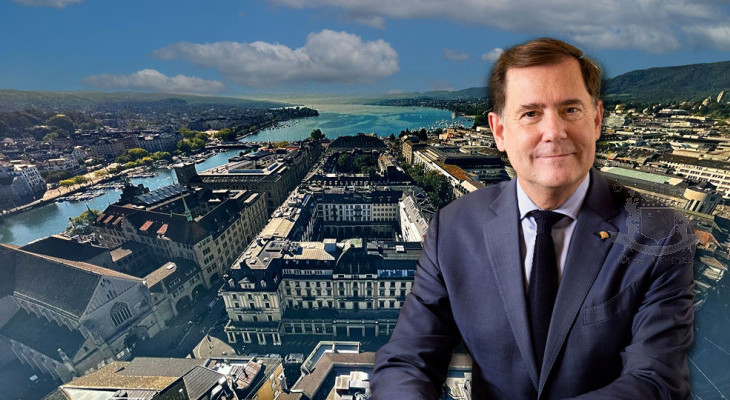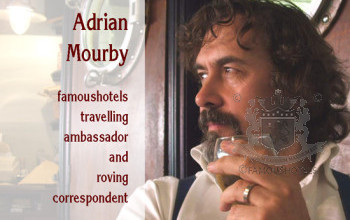A Christmas Carol
( words)
Top: a bird's view from the top of the Mandarin Oriental Savoy, Zurich inset: GM Mark Bradford
By Andreas Augustin
 A CHRISTMAS CAROL
A CHRISTMAS CAROL
Mark Bradford, born Swiss, the offspring of Scottish immigrants, stands poised upon the rooftop terrace of the Mandarin Oriental Savoy, Zurich — the hotel he is reopening at Christmas 2023. His gaze sweeps across the urban sprawl towards Lake Zurich, capturing the Alps draped in snow, glistening like crystalline marvels under the sunlight.
“Isn’t this vista simply breathtaking? On the hotel’s debut in 1838, perched atop were dainty orange trees. In the heart of winter! We shall adorn the space with Mandarin trees. Come spring, this rooftop terrace shall evolve into the epicenter of downtown.”
At the age of 22, Bradford (having completed his studies at Collège Saint Michel in Fribourg, Switzerland, under the tutelage of Economics Professor Joseph Deiss and at the legendary ehl ecole hôtelière de lausanne) stumbled into the realm of hospitality following his stint in the military in Graubünden. It was the legendary General Manager Kurt Wachtveitl who offered him an apprenticeship at The Oriental in Bangkok. That marked the indelible moment when he became ensnared by the infectious allure of the hospitality industry. Furthermore, he imbibed the tenets of the (later Mandarin) Oriental philosophy.
After decades spent abroad, he has now returned to his roots as the General Manager of the Mandarin Oriental Savoy, Zurich. In short: “the heart” of the town. "Six floors below us, Bahnhofstraße converges into Paradeplatz. If one were to place a cartographic pin here, it would precisely mark the most expensive real estate spot in the world. Every Swiss person has known since childhood that this Paradeplatz and Bahnhofstraße represent the most expensive properties on every Monopoly board."
We have met Mark at the Mandarin Oriental in Bangkok in the 1990s, during its recurrent accolades as the preeminent hotel globally, and as we delved into the history of this Thai hotel classic to produce the book The Oriental — The Amazing Tale of Bangkok's Legendary Hotel. He recently inquired of me, ‘What knowledge do you possess regarding the history of the Savoy in Zurich? Or Baur en Ville. Or Baur?’
“Quite a bit. Have you got a minute? After all, this stands as Zurich’s oldest Grand Hotel,” was my response.
Shall we embark? Join me while we travel backwards some 200 years. It was an individual from the Austrian province of Vorarlberg, a certain Johannes Baur, who inaugurated this hotel in 1838. He partnered with the then-unrecognized, yet subsequently esteemed architect Daniel Pfister, who would eventually carve a name for himself as a renowned hotel architect. Pfister later took on the construction of the ‘Neue Krone,’ presently the domicile of the Kronenhalle.

HOTEL BAUR — with Johannes Baur — a 1838 illustration showing the new hotel Baur, today Savoy.
By 1838, Baur was already a familiar figure in Zurich. He had been a denizen since 1825. Married a certain Anna Knechtli. Managed a café on Marktgasse. Subsequently, he procured a house and introduced the beer tavern ‘Zum Meierli.’ If I divulge that this establishment corresponds to the current Restaurant Orsini, you’ll grasp the reference. From that juncture, it was a somewhat convoluted yet not excessively protracted journey to acquire the contiguous property and erect a hotel.
Reflecting back on the year 1838: Zurich was a burgeoning commercial hub. Intellectual pursuits flourished at the universities. Liberal ideologies were gaining traction. Silk manufacturing constituted a pivotal aspect of Switzerland’s economy; the earliest mechanical weaving mills were being installed. The ‘Silk Yards’ in Zurich attained global renown, with the silk industry ranking amongst the foremost industrial sectors. Around 1830, Switzerland led European nations in per capita value of exported goods. Concurrently, the banking sector expanded. In 1815, there were merely ten banks in Switzerland; by 1830, the count had burgeoned to 74. Transportation underwent a transformation with the enhancement of crucial mountain passes. The maiden steamships navigated the lakes. The nascent hotels emerged, and the earliest tourists were ‘spotted.’
Zurich housed a mere 15,000 inhabitants. Bahnhofstrasse (Train Station Road) was non-existent (owing to the absence of a train station). No Paradeplatz. Ergo, seemingly, the locale where Johannes Baur unfurled his hotel lacked any discernible allure. Well, not precisely. Right opposite the hotel, in 1838, loomed the Posthof, now reincarnated as the ‘Zentralhof.’
 The ‘Post’ didn’t merely dispatch letters but primarily ferried people. This was essentially the ‘main station’ of Zurich. It was the point of arrival for all and the departure point for everyone. There existed no superior location in the entire city to inaugurate a hotel. Specifically, where there was hope that sooner or later the train station would be built nearby.
The ‘Post’ didn’t merely dispatch letters but primarily ferried people. This was essentially the ‘main station’ of Zurich. It was the point of arrival for all and the departure point for everyone. There existed no superior location in the entire city to inaugurate a hotel. Specifically, where there was hope that sooner or later the train station would be built nearby.
By the end of the 1830s, the market was hungry for a good hotel. The situation at the time is best described by Murray's first guidebook of Switzerland (1837): ZURICH-Inns: The inns at Zurich are notoriously dirty, high priced and ill attended: they have hitherto enjoyed a monopoly, and there has been no inducement to improve.
Baur embarked on this venture with unparalleled fervor. The sheer number of rooms surpassed anything hitherto classified as a grand inn. Beyond 142 ‘rooms,’ stabling for 40 horses and ten carriages were provided. It essentially heralded the advent of Zurich’s inaugural Grand Hotel. In Geneva, stood the ‘Hôtel des Bergues,’ extolled for its luxury and a few years senior. Even the venerable ‘Drei Könige’ in Basel lag far behind what it aspired to become.

The salons were tailored to cater to the needs of voyagers. A dedicated Damensalon - ladies’ salon - was conceived to accommodate female travellers who found themselves uncomfortable amidst the cigar and pipe-laden ambiance of the gentlemen’s salons. In the library, where patrons whiled away time until the departure of the next stagecoach, the English guest pored over his ‘Murray’s,’ the diminutive red compendium, discovering that the journey from Zurich to Paris spanned three days. In the dining hall, illuminated and warmed since five in the morning, guests convened four times daily for the expeditiously served ‘table-d’hôtes’ meal, accompanied by wine or beer.
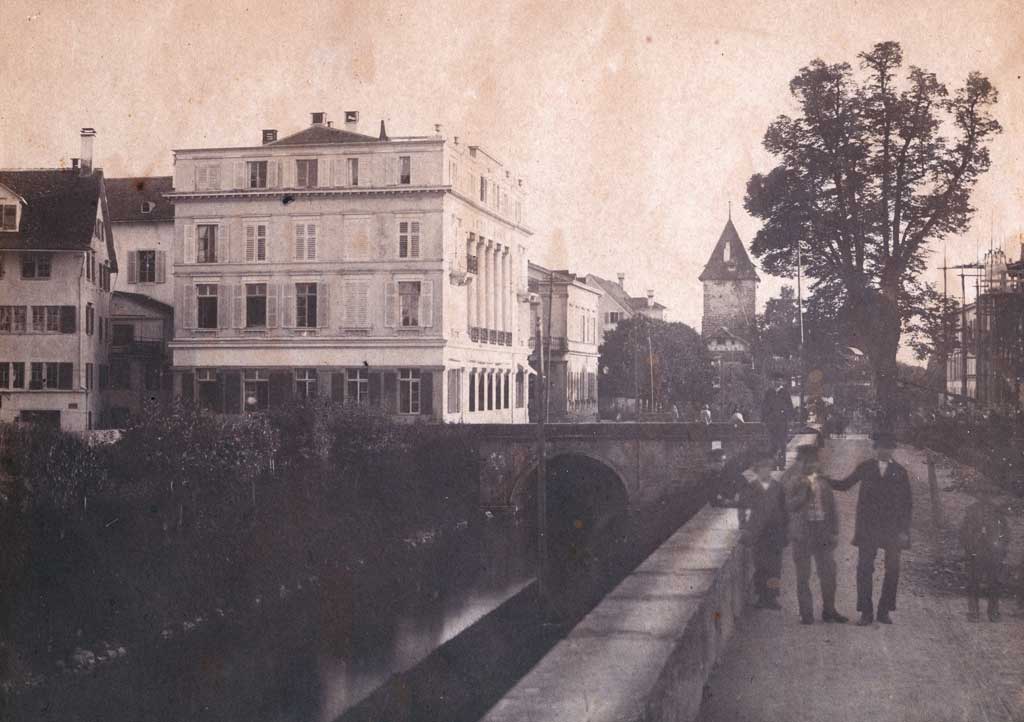
The white elegant building of the hotel and the frogs' ditch Froschengraben in front of it.
Lying ahead of the hotel was the Froschengraben, a trench eventually transmuted into Bahnhofstrasse. The ambiance was not always fragrant. Thus, the Belvedere towered above as the zenith of the hotel. This delightful rooftop garden, boasting a 100-metre long, three-metre wide walkway, was christened as such. Here, during sultry summer days, one strolled high above the thoroughfare amidst pristine air. Passing by miniature orange trees, one could gaze upon the city, the Fraumünster. Not far off, the lake gleamed. What a Biedermeier tableau unfolded here. Travellers relished the panoramic vista. ‘Oh look! Oh my God. Is that snow on the mountains?’
At the petite tables on the rooftop terrace, patrons frequently ordered a chilled beer and a bratwurst paired with sauerkraut. ‘Right away!’ echoed the attendant, the nomenclature reserved for the waiter. He turned towards a funnel and announced the order within. ‘Else, he remains stationary!’ bemoaned a disillusioned guest, before realising, ‘Three storeys below, every desire is instantaneously catered for in the kitchen and promptly dispatched via a food lift. It’s an innovation that’s unmatched. Ordering via speaking tube and a dumb waiter!’
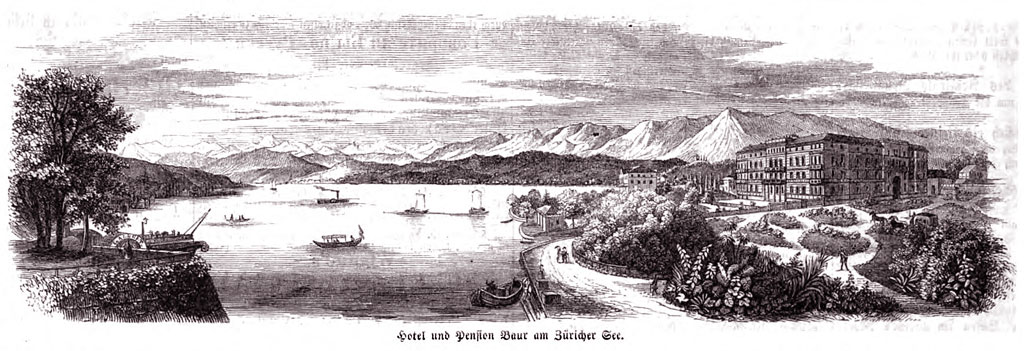
This illustration celebrated the new building and its new facade (1854) of the Hôtel Baur au Lac at the Lake Zurich
"Even a lakeside property piqued Baur's interest. He envisaged a grand hotel there, featuring its most exquisite rooms and balconies overlooking the lake. Utter nonsense, they told him in the city. Who would want to gaze over the lake? Well, times do change. What would Zurich be today without the Baur Au Lac?
Let's stay within the realm of Baur in the city, soon to be christened Baur en Ville to distinguish it from its younger sibling by the lakeshore. Around 1910, the name took a turn towards Savoy. And today, it stands as the Mandarin Oriental Savoy, Zurich.
I'll spare you the intricacies of various additions and renovations. However, it's noteworthy that the original Hotel Baur was expanded several times, extensively around 1908, and the entire hotel was simply demolished in 1975. The most distinctive elements of the facade were removed beforehand and meticulously reinserted after reconstruction.
Our research embarks on another intriguing phase
We've delved into the guest registers of the early decades. Tourism in Zurich was shaped by business travellers; addresses of hotel guests ranged from China and the Dutch East Indies to New York. Many Swiss merchants, famous names from old families. Let's not forget that over 250,000 Swiss Francs from investors in Switzerland were allocated for the hotel's construction.
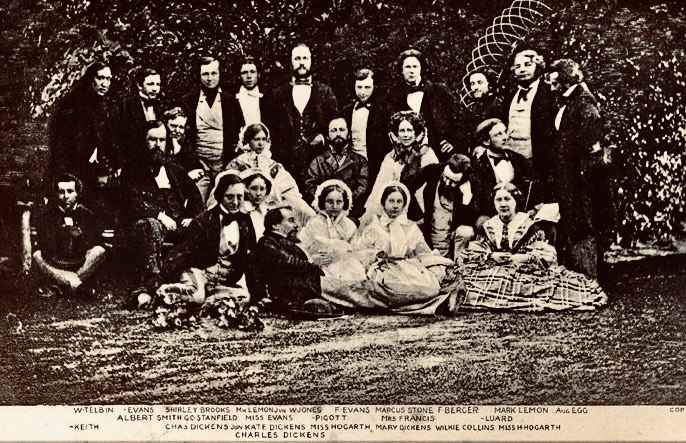
The Dickens family: when they travelled together they needed quite a number of rooms!
And then, of course, the legendary names. One day, from a carriage emerged a man with curly hair and a goatee, alongside his wife, five children, four servants, and likely a few more, as there are records of 13 individuals arriving with Charles Dickens. Two years after he published his famous 'A Christmas Carol' he arrives in Zurich in 1845.
Dickens had taken a break with his large family for almost a year in Italy, July 1844-June 1845, in a decade when Europe, including Italy itself was seething with revolution. London was a poluted city. On his way back from Italy he resides at the Hotel Baur. His literature, such as Oliver Twist or A Christmas Carol, was already known by every child in Switzerland at that time.
Speaking of Switzerland: it didn't exist yet. It was founded as a federal state three years later, in 1848. A democratic experiment that drew wary amazement from the royal houses and princely courts of Europe.
 Felice Orsini
Felice Orsini
Looking at the list of guests who stayed here back then, I notice that some had participated in the Congress of Vienna in 1815. Some probably even knew Napoleon personally. At least from a battle. By the way, Napoleon was the uncle of Napoleon III, who narrowly survived an assassination attempt in Paris in 1858. That's intriguing for our story. The assassination was carried out by a certain Count Felice Orsini. Orsini was subsequently executed. His revolutionary friends in Zurich commemorated him. They hung a portrait of him in the 'Zum Meierli' inn at the rear of the Hotel Baur. Soon after, the inn was renamed 'Orsini,' presumably because locals used to say, 'Let's go to Orsini.' Now you know this tale too.
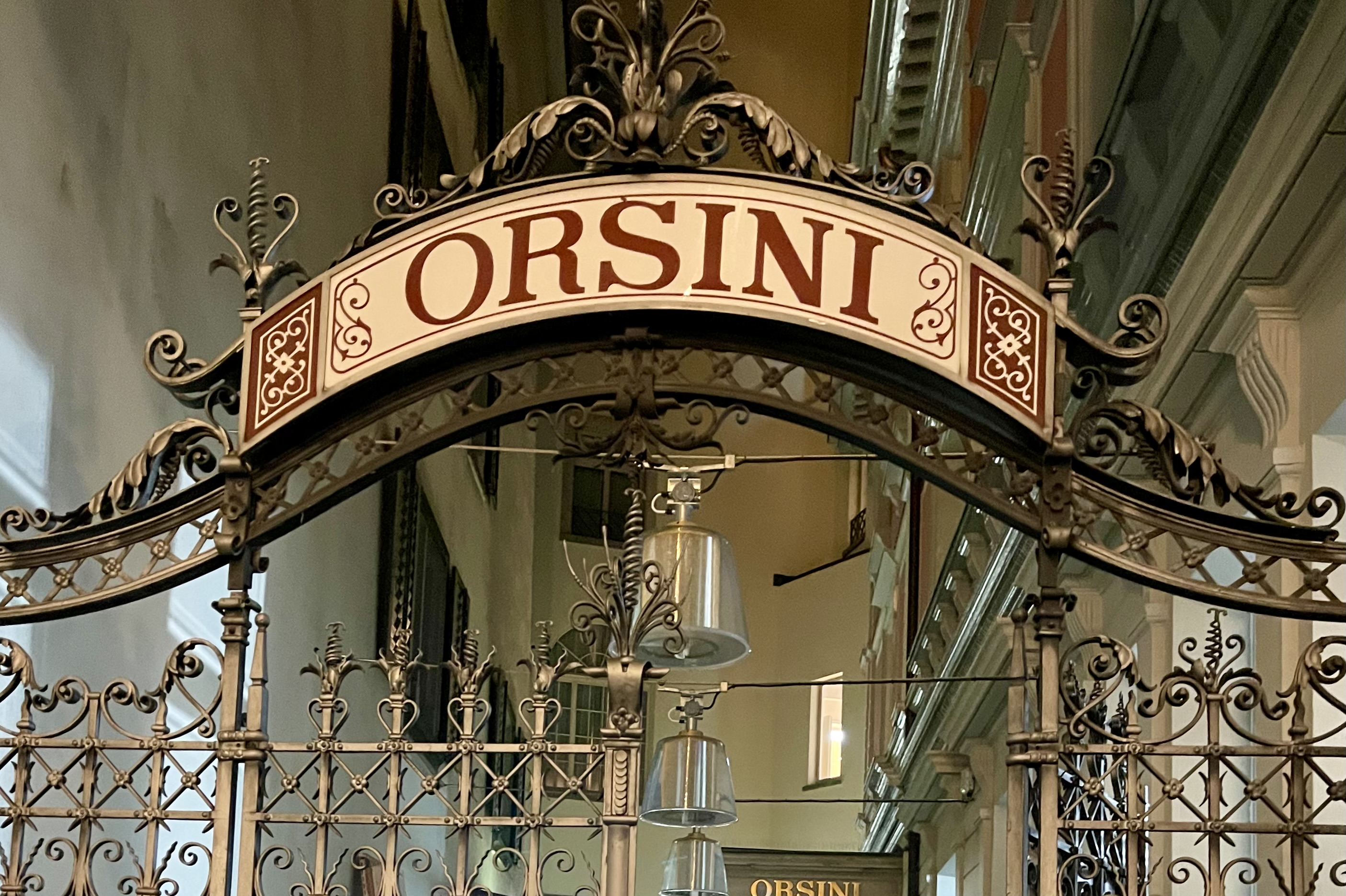
I could regale you endlessly with stories of guests like Franz Liszt and Richard Wagner, Clara Schumann who practiced for her piano concerts in the ladies' salon, or the King of Bavaria's lover who hid in the hotel, waiting for her love to arrive.
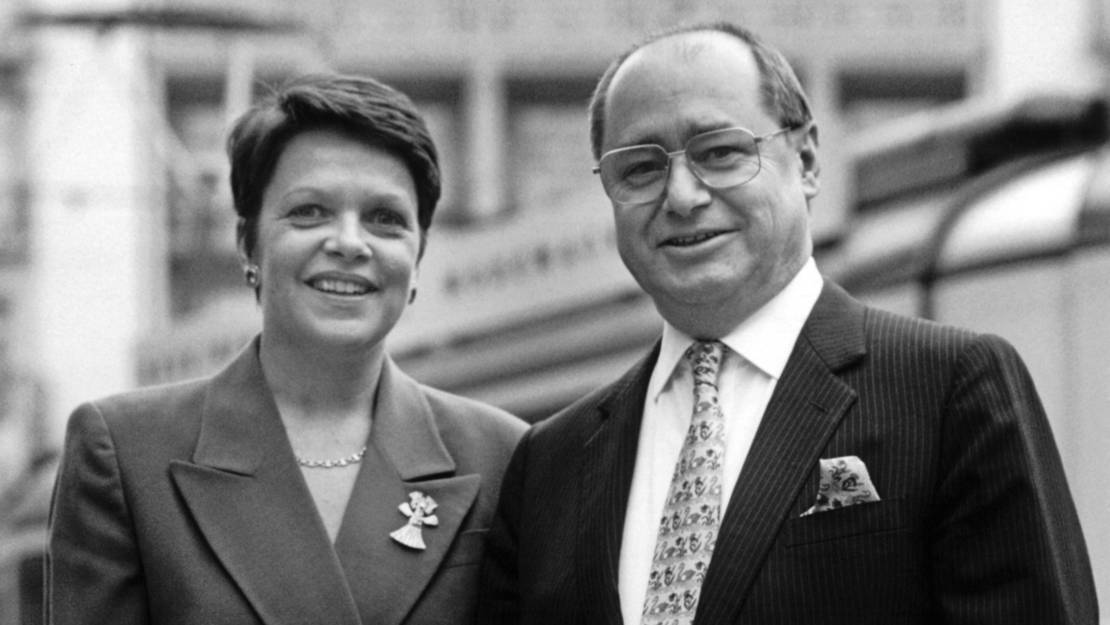
Dedicated hoteliers: Christina and Manfred Hörger managed the hotel for decades
Or of the fantastic hotel directors who, throughout these decades, successfully kept the hotel thriving. Naturally, the Baur family, then the Michls as independent leaseholders from 1930, followed by directors Hörger, Knechtli, Brönnimann, and all those diligent souls not mentioned here.
From December 21st, 2023, the hotel will reopen after a two-year renovation. This time, it's known as the Mandarin Oriental Savoy, Zurich.
General Manager Mark Bradford is delighted with 80 'room keys.' A jest! As they are, in fact, keycards for 36 quite spacious suites and 44 'standard' rooms - all designed by the Parisian star designer Tristan Auer.
The historic ballroom remains in the same location but has, of course, been renovated. There are ten meeting rooms, the guild room of the Tanners and Shoemakers (stalwart guests for a century!) with original parquet flooring, the Savoy Brasserie & Bar, and, naturally, the Orsini.
Oh yes, the rooftop terrace is reopening too. It's named '1838.' Instead of orange trees, this time, there are Mandarin trees, fitting for the hotel group's name.
--------------- fin --------------
Hotel manager Kai Jansen
Chief concierge Berkan Caglar
Staff: 150 for 80 rooms

